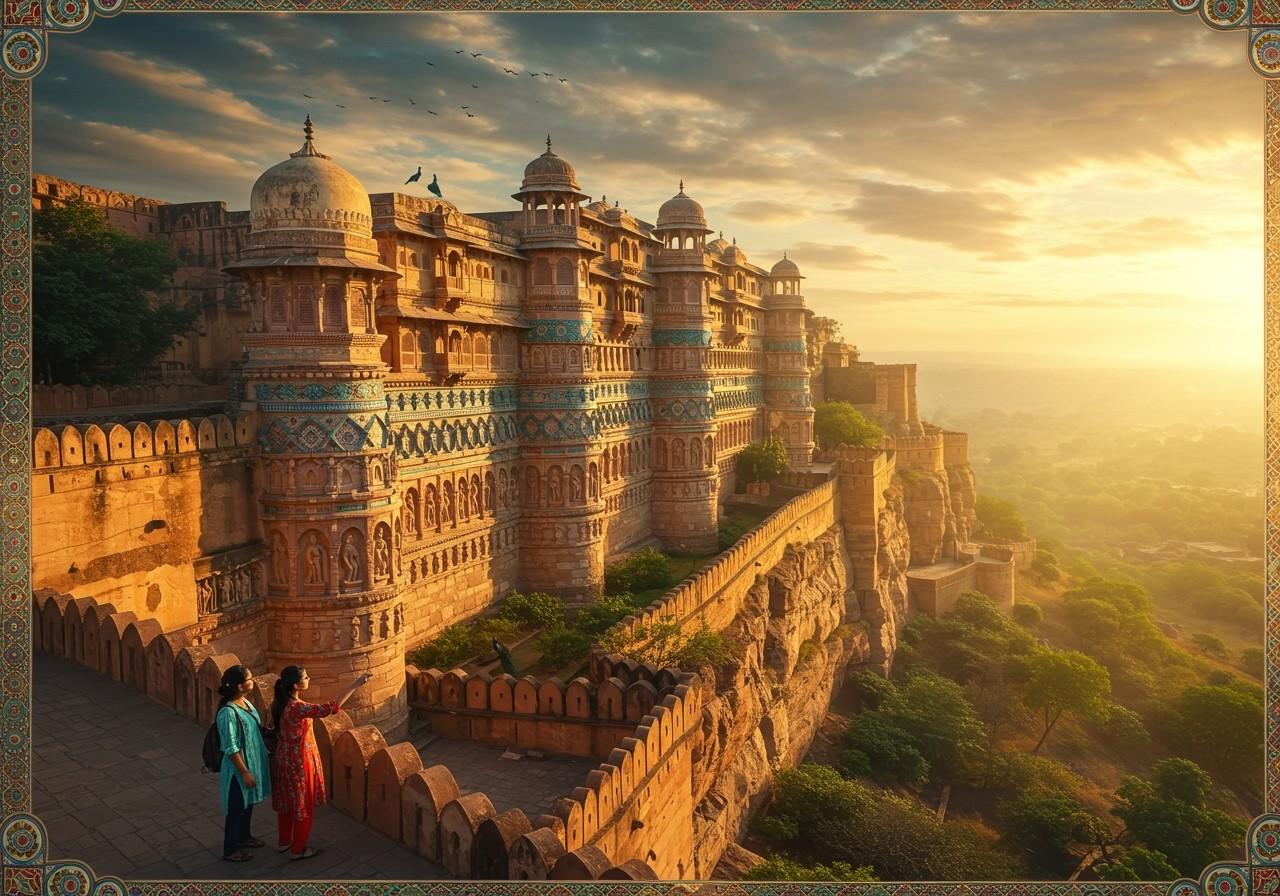
Gwalior Fort, a majestic fortress perched atop Gopachal Hill in Gwalior, Madhya Pradesh, stands as a testament to India’s rich history, architectural brilliance, and cultural heritage. This imposing structure offers visitors a captivating glimpse into centuries past, showcasing a blend of architectural styles, intricate carvings, and significant religious sites. Despite its historical importance and stunning beauty, Gwalior Fort remains a hidden gem, offering a tranquil and enriching experience for those who venture to explore its wonders. Its convenient accessibility from the city and train station further enhances its appeal for travelers.
A Glimpse into the Past: History of Gwalior Fort
The history of Gwalior Fort is as captivating as its architecture. Dating back to the 6th century, the fort has witnessed the rise and fall of empires, playing a pivotal role in numerous historical events. From the Tomars and Mughals to the Marathas and the British, each dynasty has left its indelible mark on the fort’s legacy. Notable figures like Raja Man Singh Tomar and Mughal Emperor Babur have shaped its narrative. The fort’s resilience through sieges and battles underscores its strategic importance throughout the ages. Even during British colonization, the fort remained a significant landmark, eventually becoming a celebrated national heritage site, preserving its place in India’s historical narrative.
Architectural Marvel: Exploring the Design and Structure
Gwalior Fort is an architectural marvel, seamlessly blending Hindu and Islamic styles. Its massive sandstone walls, adorned with intricate carvings, speak volumes about the craftsmanship of a bygone era. The vibrant tilework and frescoes of the Man Mandir Palace, a jewel within the fort, transport visitors back in time. The fort also houses a diversity of religious structures, including Hindu temples like the Sas Bahu Temple dedicated to Lord Vishnu and the Teli Ka Mandir dedicated to Lord Shiva, and Jain temples, each showcasing unique architectural features. The fort’s strategic gateways, bastions, and defensive design elements highlight its military significance, reflecting its ability to withstand numerous sieges over centuries. Ongoing restoration efforts ensure that future generations can continue to marvel at this magnificent example of India’s architectural heritage.
Cultural Significance and Spiritual Resonance
Beyond its architectural splendor, Gwalior Fort holds immense cultural and spiritual significance. It represents the rich heritage of Gwalior, serving as a hub for art and culture, particularly during the reign of Raja Man Singh Tomar. The fort’s association with legendary figures like Tansen, a prominent figure in Hindustani classical music, further enriches its cultural legacy. As a pilgrimage site, the fort attracts devotees from various faiths, drawn to its temples and religious structures. This spiritual dimension adds depth to the fort’s cultural importance. Its influence on Indian art and architecture continues to inspire generations of craftsmen. Recognized as a UNESCO World Heritage Site, Gwalior Fort’s global importance is undeniable.
Planning Your Visit: A Guide for Travelers
Planning a trip to Gwalior Fort? Consider visiting during the pleasant weather months between October and March for an optimal experience. Guided tours provide valuable insights into the fort’s history and architecture, enhancing your exploration of key attractions like the Saas Bahu Temples and the Gujari Mahal Museum. The fort’s accessibility from the city and train station ensures a convenient journey for all visitors. Check for special events or festivals that might coincide with your trip for an added cultural immersion. Remember to be respectful of the site’s cultural and historical significance during your visit.
Poojn.in: Enhancing Your Spiritual Journey at Gwalior Fort
Gwalior Fort’s numerous temples offer a unique spiritual experience. Poojn.in, India’s leading online store for spiritual and puja items, can enhance your visit with authentic and high-quality products. Whether you’re visiting the Saas-Bahu Temple or the Teli Ka Mandir, we have everything you need:
- For Lord Vishnu at Saas-Bahu Temple: Brass Laddu Gopal Murti, Brass Radha Krishna Murti, Panchamrit containers, traditional brass bells, pure copper kalash sets, and authentic cotton wicks.
- For Lord Shiva at Teli Ka Mandir: Rudraksha malas, pure copper kamandal, brass dhoop stands, and traditional bel patra holders. Arjun Chal is also available for specific rituals.
Poojn.in offers complete puja thalis for special occasions, ensuring ritual purity with quality-checked products from authentic manufacturers. We deliver across India, providing convenient access to essential puja items before your temple visit. Each product includes usage instructions for correct ritual performance. Visit www.poojn.in or contact our customer service for guidance.
Conclusion: A Timeless Legacy
Gwalior Fort stands as a timeless symbol of India’s rich past and enduring legacy. Its architectural grandeur, historical significance, and spiritual resonance captivate all who visit. As a bridge between the ancient and the modern, Gwalior Fort offers a unique and enriching experience, inviting exploration, learning, and appreciation. Plan your visit and immerse yourself in the stories and traditions that make this magnificent fort a cherished monument.


